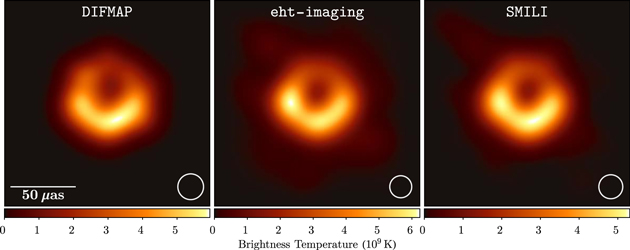Interferometric imaging algorithms
Obtaining images of cosmic objects at higher angular resolution and higher accuracy is a fundamental demand in modern astronomy. Radio interferometry is a technique for improving angular resolution by assembling many telescopes and forming a large virtual telescope with a sharper view than each telescope on its own. Modern radio astronomy has been utilizing various interferometric arrays, such as the Atacama Large Millimeter/sub-Millimeter Array (ALMA) and the Event Horizon Telescope (EHT).
Imaging is a key process in radio interferometry, which turns calibrated data into astronomical images with mathematical imaging algorithms. Haystack is at the forefront of imaging algorithm developments primarily driven by the EHT to reconstruct high-quality black hole images under many technical challenges.

RML algorithms and SMILI
Haystack has developed new imaging techniques, collectively referred to as regularized maximum likelihood (RML) methods. RML methods have proven to be better than traditional imaging methods, and often provide modest super-resolutions.
Our group’s scope is not only on the algorithmic development but also on implementing them into software packages and utilizing them for cutting-edge science. For instance, Haystack has led the development of the Sparse Modeling Imaging Library for Interferometry (SMILI), an imaging software package implementing various new imaging techniques developed for the EHT. SMILI is one of three imaging software packages used to create the first-ever picture of a black hole.
Applications of SMILI has been expanded to real and simulated observations with the existing and future instruments, such as ALMA, the Very Large Array (VLA), and the Next-Generation VLA (ngVLA) (see our Radio Stars project). Our group has been actively developing techniques for the next decade of science with the next-generation EHT and other interferometric instruments.
This is an example movie reconstruction from simulated observations of an evolved star with the next generation Very Large Array (ngVLA) presented in Akiyama & Matthews (2019).
Project team
- Kazunori Akiyama
- Vincent Fish
- Lynn Matthews
- Kotaro Moriyama
- Leonid Benkevich